Kaiyuan Temple Pagoda: Discovering the Historical Significance of Dingzhou’s Gem
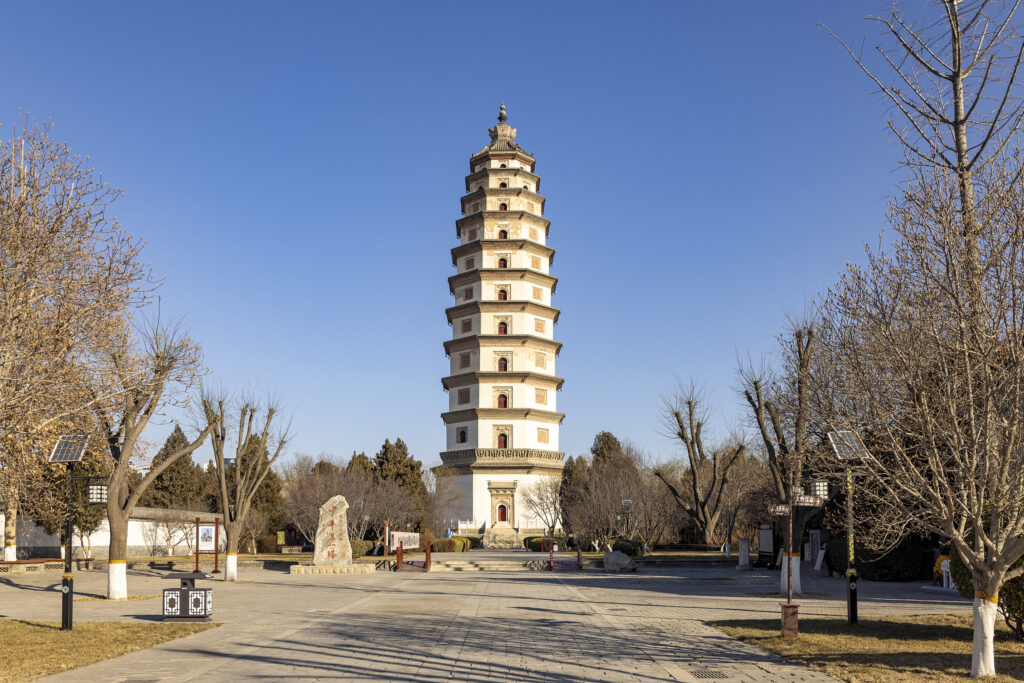
An Essential Guide to Visiting Kaiyuan Temple Pagoda Dingzhou
In This Guide
- An Essential Guide to Visiting Kaiyuan Temple Pagoda Dingzhou
- The Rich History and Legends of Kaiyuan Temple Pagoda Dingzhou
- Main Highlights: What You Absolutely Can’t Miss
- Planning Your Visit: A Practical Guide
- Tickets: Prices, Booking, and Tips
- How to Get There: A Complete Transportation Guide
- Local Cuisine and Accommodation Nearby
- Frequently Asked Questions
- Final Thoughts on Your Trip
Nestled in the vibrant city of Quanzhou, the Kaiyuan Temple Pagoda Dingzhou stands as a testament to the rich tapestry of Chinese history and culture. With origins tracing back to the Tang Dynasty, this ancient Buddhist temple complex is not only one of the oldest in Fujian Province but also a remarkable symbol of maritime trade and cultural exchange that flourished in the region. As you step through its ornate gates, you are transported into a world where time seems suspended, allowing you to explore intricate architecture and sacred spaces steeped in spirituality.
The temple’s grand design features striking twin stone pagodas, each adorned with exquisite carvings that reflect the artistry of the era. The history of Kaiyuan Temple is as fascinating as its physical presence; it began its journey in 685 AD and has evolved through centuries of devotion and reverence. Visitors are often captivated by the solemnity of the Buddha hall, where incense wafts through the air as worshippers seek blessings and reflect on their spiritual journeys.
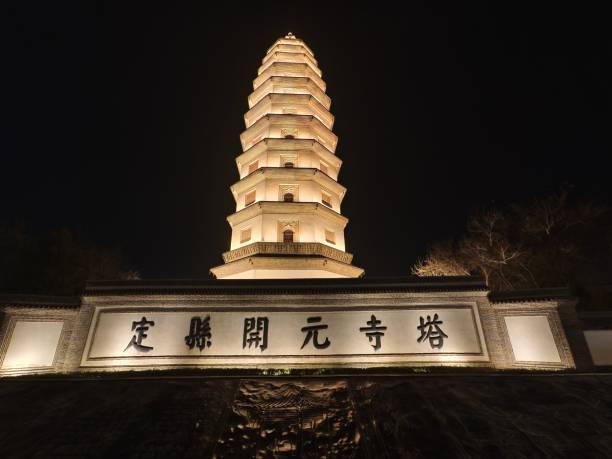
Kaiyuan Temple Pagoda Dingzhou.
As you plan your visit, prepare to be enchanted not only by the temple’s architectural brilliance but also by the rich narratives that each corner of the complex holds. Surrounding the temple, the bustling food streets offer a taste of local delicacies, inviting you to indulge in the culinary heritage of Quanzhou. Whether you are an avid history buff, a spiritual seeker, or simply a curious traveler, the Kaiyuan Temple Pagoda Dingzhou promises an unforgettable experience that connects you deeply with the essence of Chinese culture and its ancient traditions.
Take a moment to immerse yourself in this sacred space, and allow the stories of the past to inspire your present.
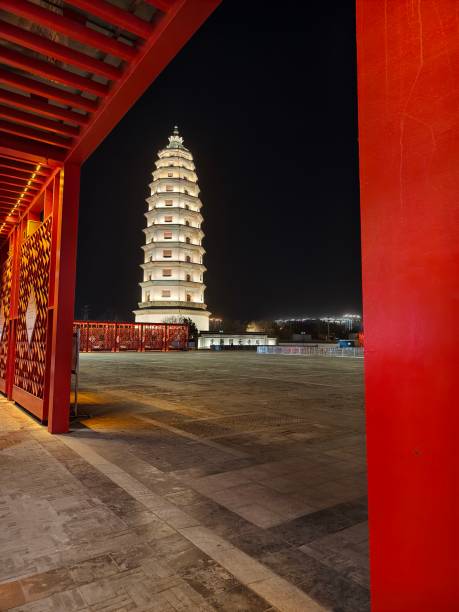
Kaiyuan Temple Pagoda Dingzhou.
The Rich History and Legends of Kaiyuan Temple Pagoda Dingzhou
Kaiyuan Temple Pagoda in Dingzhou, a remarkable emblem of China’s rich cultural tapestry, invites visitors to explore its storied past and the legends that have blossomed around it. As one of the oldest and most significant Buddhist temples in the region, its history is intricately woven into the fabric of Dingzhou and the broader narrative of Chinese Buddhism.
A Journey Through Time
The origins of Kaiyuan Temple stretch back to the Tang Dynasty (618–907 AD), during which it was established as a vital center of Buddhist worship and scholarship. Originally named the Lotus Temple, it was built on a mulberry tree field by a wealthy man, Huang Shougong, who was inspired by a prophetic dream of a lotus flower blossoming. This profound vision led to the temple’s creation, symbolizing purity and enlightenment.
As the temple evolved, so too did its name and significance. By 739 AD, it was officially renamed Kaiyuan Temple, reflecting the era’s reign. Over the centuries, it has been a sanctuary for monks, scholars, and worshippers, earning its place as a pivotal landmark in the cultural and spiritual life of Dingzhou.
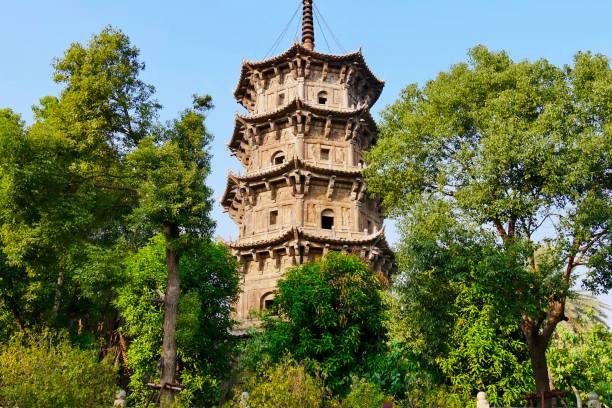
Kaiyuan Temple Pagoda Dingzhou.
Architectural Marvel
One of the temple’s most striking features is its stone pagoda, which stands as a testament to the artistry of ancient builders. The twin stone pagodas, known for their rust-colored exterior, date back to the 13th century and are adorned with intricate carvings. The architecture reflects a blend of Buddhist and Hindu influences, showcasing the cosmopolitan nature of Quanzhou during its peak as a maritime trade hub.
Legends and Lore
The legends surrounding Kaiyuan Temple add a layer of mystique to its already enchanting history. One popular tale speaks of a dragon spirit that resides within the temple grounds, believed to protect the temple and its visitors. Many local villagers still leave offerings at the temple, hoping to gain favor from this protective spirit, which they believe brings peace and prosperity to the community.
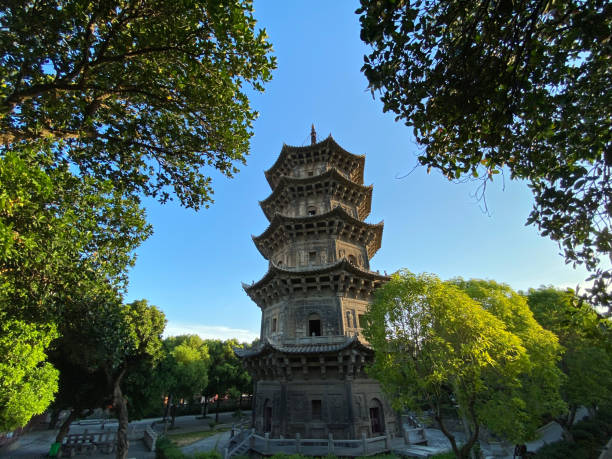
Kaiyuan Temple Pagoda Dingzhou.
Another legend recounts the story of a wandering monk who, after a long journey, arrived at the temple seeking solace. It is said that upon entering the Daxiong Palace, he was greeted by a vision of the Buddha, who imparted wisdom that transformed his life. This story underscores the temple’s role as a place of spiritual awakening and enlightenment, attracting seekers from all walks of life.
Cultural Significance
Kaiyuan Temple is not merely a historical site; it embodies the rich cultural interactions that have taken place over the centuries. Quanzhou was once the starting point of the Maritime Silk Road, and the temple stands as a symbol of the cultural exchanges that occurred through trade and interaction with foreign lands. This confluence of ideas and beliefs has shaped the development of Chinese Buddhism and its practices.
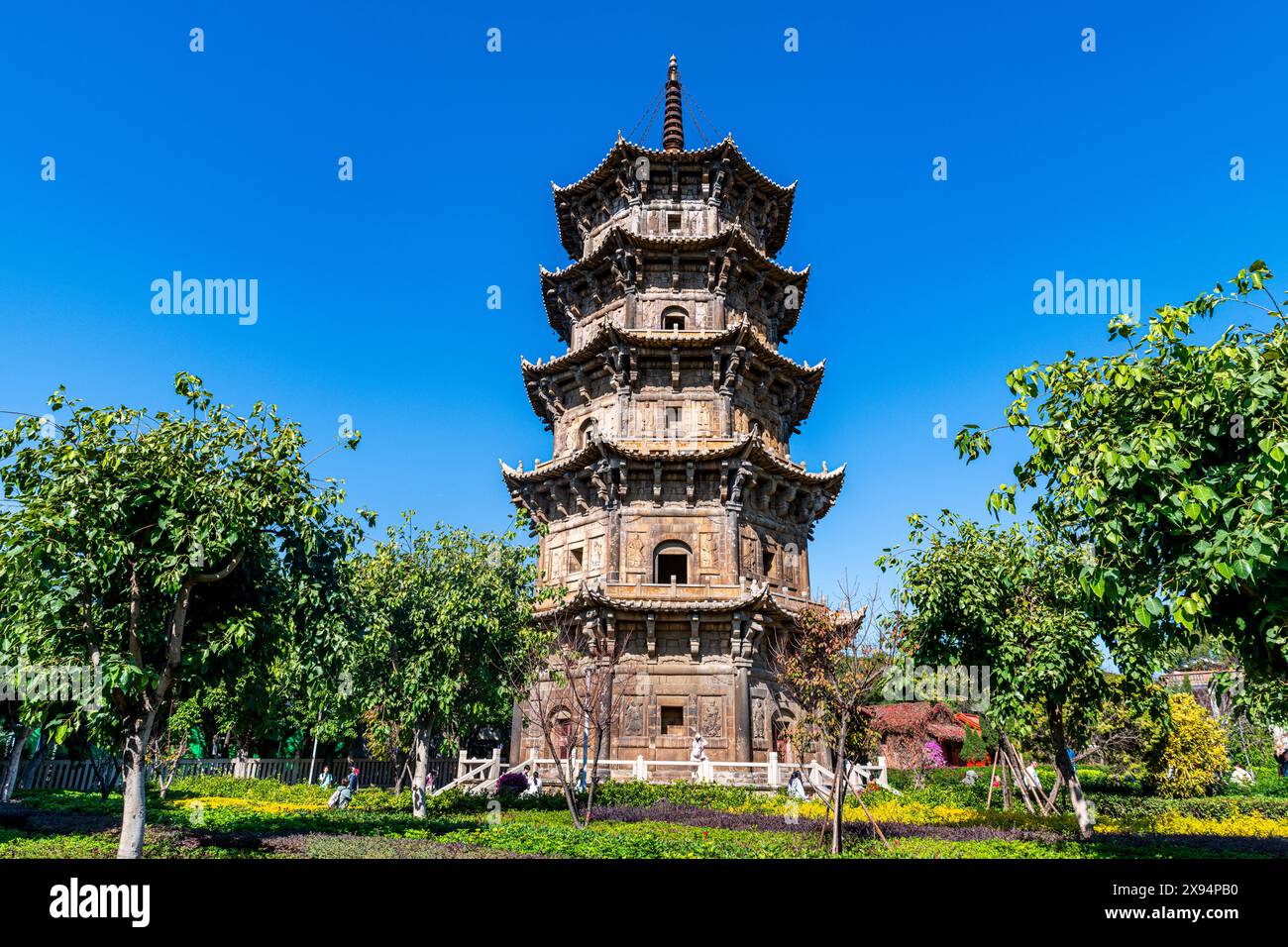
Kaiyuan Temple Pagoda Dingzhou.
Visitor Experience
Today, visitors to Kaiyuan Temple can immerse themselves in its tranquil atmosphere, exploring its numerous halls, palaces, and the solemn Buddha hall where worshippers offer incense and prayers. The temple’s grounds are free to enter, allowing everyone to appreciate its historical significance without financial barriers. It is advisable to engage a local guide to truly appreciate the depth of the stories embedded within the temple’s walls.
In summary, the Kaiyuan Temple Pagoda in Dingzhou stands as a remarkable testament to the enduring legacy of Chinese Buddhism, its rich history, and the captivating legends that continue to inspire visitors. Whether one is drawn by the allure of its architecture, the stories of its past, or the spiritual serenity it offers, Kaiyuan Temple is undoubtedly a must-visit destination for anyone interested in exploring the depths of Chinese culture and history.
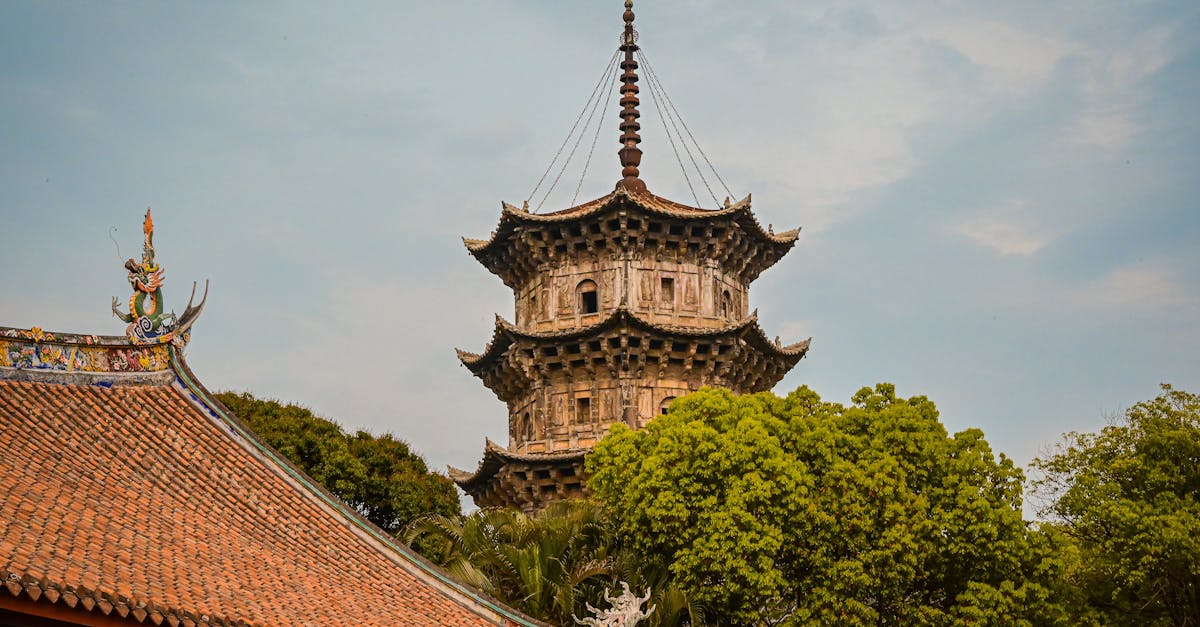
Kaiyuan Temple Pagoda Dingzhou.
Main Highlights: What You Absolutely Can’t Miss
Discover the Wonders of Kaiyuan Temple Pagoda Dingzhou
Nestled in the heart of Quanzhou, the Kaiyuan Temple Pagoda Dingzhou is a historical treasure that offers visitors a glimpse into the rich tapestry of Chinese culture and Buddhism. With roots tracing back to the Tang Dynasty, this ancient complex is a must-visit for any traveler seeking to immerse themselves in the profound legacy of China’s spiritual and architectural heritage. Here’s what you absolutely can’t miss during your visit.
1. The Daxiong Palace
As the centerpiece of the temple complex, the Daxiong Palace (Hall of Purple Clouds) is a stunning example of traditional Chinese architecture. Supported by 86 majestic stone pillars, this grand hall houses impressive Buddhist statues and provides a serene atmosphere for prayer and reflection. Make sure to take a moment to admire the intricate carvings and the overall craftsmanship that date back over a thousand years.
2. The Twin Stone Pagodas
One of the defining features of Kaiyuan Temple are its iconic twin stone pagodas, which stand as sentinels of history. Built during the 13th century, these rust-colored structures not only showcase exquisite architectural design but also serve as a symbol of Quanzhou’s maritime trade history. Standing at the foot of these pagodas, you can truly appreciate their grandeur and the stories they hold.
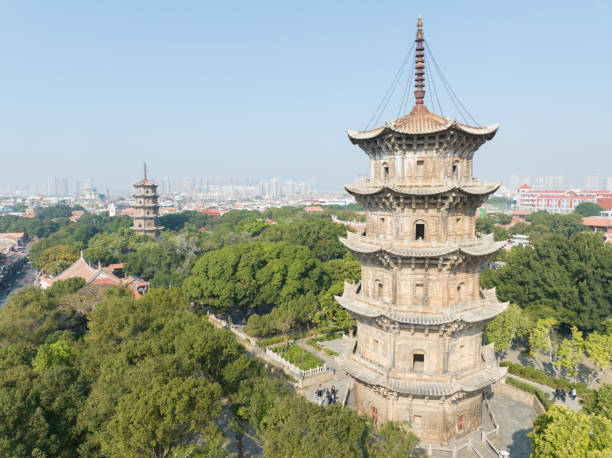
Kaiyuan Temple Pagoda Dingzhou.
3. The Buddha Hall
A visit to the Buddha Hall is essential for anyone looking to experience the spiritual essence of the temple. Here, visitors engage in the time-honored practice of offering incense and prayers. The atmosphere is one of tranquility, making it a perfect spot for reflection. Note that photography is not permitted in this sacred area, so take a moment to absorb the ambiance and respect the customs observed by local worshippers.
4. The Maritime History Artifact
Kaiyuan Temple is home to an intriguing Song Dynasty ship, a remarkable artifact that speaks volumes about Quanzhou’s historical significance as a maritime hub. This preserved ship allows visitors to connect with the region’s rich maritime heritage and offers a unique opportunity to explore an essential part of China’s trading past.
5. The Surrounding Food Streets
After soaking in the historical and cultural wealth of the temple, take a leisurely stroll to the nearby food streets. These vibrant lanes are brimming with local delicacies, including fresh seafood and roasted duck. While vegetarians may find fewer options, the culinary adventure is worth the exploration. Enjoy the hustle and bustle as you sample the flavors that reflect the local culture.
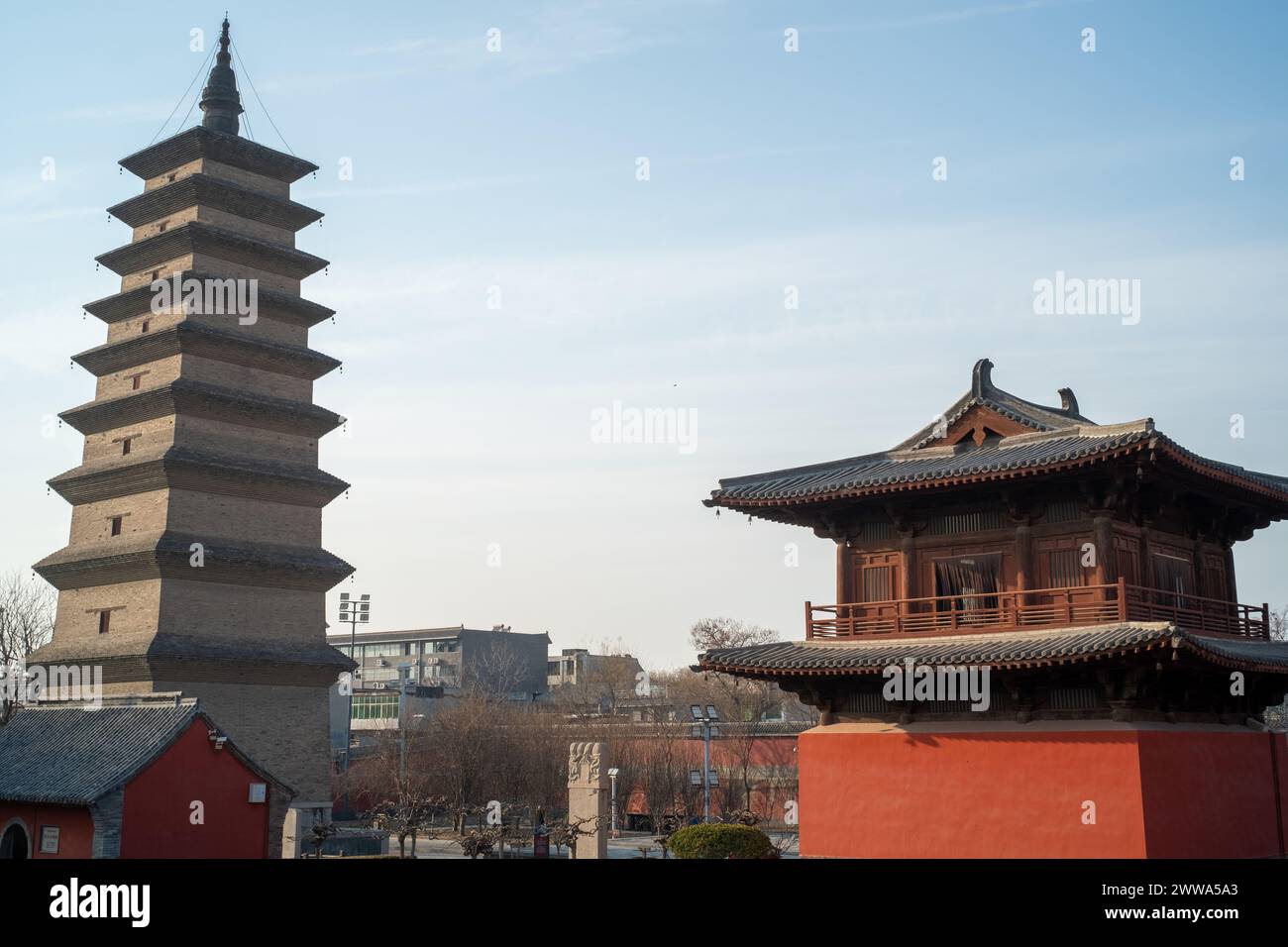
Kaiyuan Temple Pagoda Dingzhou.
6. Engage a Local Guide
To deepen your understanding of Kaiyuan Temple’s history and significance, consider hiring a local guide. Their insights can unveil hidden stories and fascinating facts that may otherwise go unnoticed, enriching your experience and appreciation of this ancient site.
7. The Ideal Visit Duration
Plan to spend at least three hours at Kaiyuan Temple to fully appreciate the beauty and history of the site. This timeframe allows for a leisurely exploration of the various halls, pagodas, and the surrounding area, ensuring you don’t miss any of the highlights.

Kaiyuan Temple Pagoda Dingzhou.
Practical Tips
- Admission: Entrance to Kaiyuan Temple is free, making it an accessible destination for all travelers.
- Opening Hours: The temple is open daily from 8:00 AM to 6:00 PM.
- Best Time to Visit: Any time of the year is suitable, but be mindful of peak seasons when the temple can get crowded.
- Respect the Rules: Observing the customs within the temple is crucial. Photography is not allowed in the Buddha Hall, so please adhere to this guideline.
Visiting Kaiyuan Temple Pagoda Dingzhou is not just a journey through history; it’s an opportunity to connect with the essence of Chinese culture and spirituality. Make sure to include this remarkable destination on your itinerary when exploring Quanzhou!
Planning Your Visit: A Practical Guide
Planning Your Visit: A Practical Guide to Kaiyuan Temple Pagoda Dingzhou
Introduction to Kaiyuan Temple
Nestled in the heart of Quanzhou, Fujian Province, the Kaiyuan Temple (开元寺) is not only one of the oldest Buddhist temples in China but also a symbol of the region’s rich maritime culture and history. With roots tracing back to the Tang Dynasty, this majestic temple complex offers a deep dive into Buddhist architectural beauty and spiritual heritage, making it a must-visit for international travelers interested in Chinese history and culture.
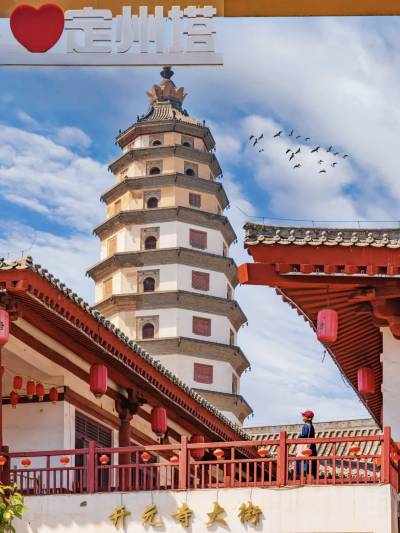
Kaiyuan Temple Pagoda Dingzhou.
Getting There
-
Address:
176 Xijie St, Licheng District, Quanzhou, Fujian, China, 362001 -
Public Transport:
Quanzhou is well-connected via public transportation, including buses and taxis. The temple is located in a bustling area, making it easily accessible. -
Best Time to Visit:
The temple is open year-round, but visiting during the cooler months (October to March) can enhance your experience, avoiding the heat and humidity typical of the summer months. Early mornings or late afternoons are ideal for fewer crowds and a more serene atmosphere.
Admission Information
-
Entrance Fee:
Entry to Kaiyuan Temple is free, allowing visitors to explore its extensive grounds without any cost. However, donations are welcomed to help maintain the site. -
Opening Hours:
Daily from 8:00 AM to 6:00 PM. It’s advisable to arrive early to enjoy a quieter experience and to fully appreciate the architecture and sacred spaces.
What to Expect
Exploring the Temple Complex
Kaiyuan Temple is a vast complex featuring several significant structures:
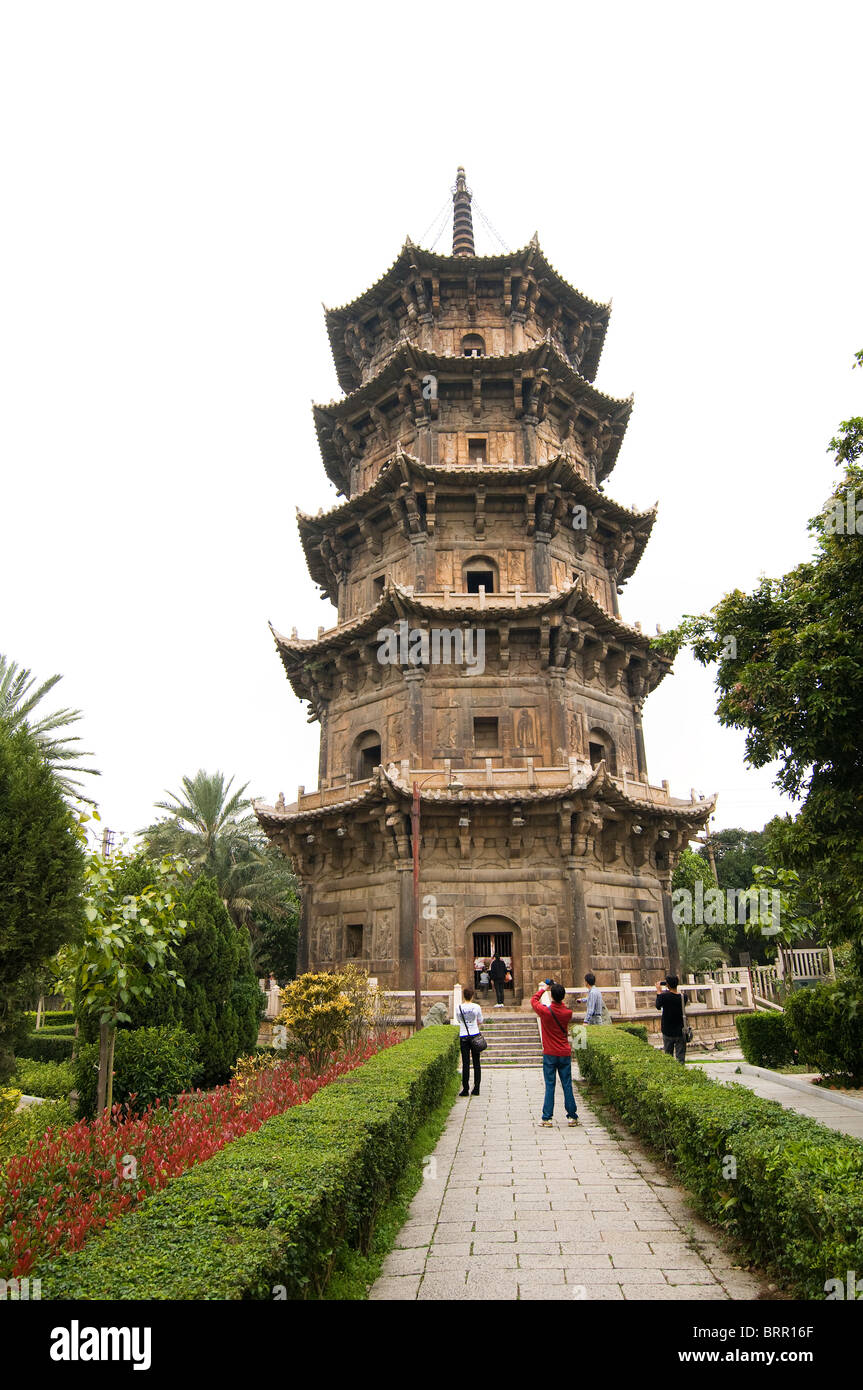
Kaiyuan Temple Pagoda Dingzhou.
-
Daxiong Palace (Hall of Purple Clouds):
The main hall of the temple, supported by 86 grand stone pillars, is a breathtaking sight. It houses beautiful sculptures and murals depicting Buddhist deities. -
Twin Stone Pagodas:
Dating back to the 13th century, these rust-colored pagodas are iconic landmarks of Quanzhou. Their intricate carvings and historical significance are a highlight of any visit. -
Buddha Hall:
A solemn space where visitors often come to offer incense and prayers. Note that photography is not allowed inside this hall, so be respectful of the rules. -
Cultural Artifacts:
Don’t miss the preserved Song Dynasty ship located within the temple grounds, which offers insight into Quanzhou’s historical significance as a maritime trade hub.
Tips for a Memorable Visit
-
Time Your Visit:
Plan to spend at least 2 to 3 hours exploring the temple complex thoroughly. This allows ample time to admire the architecture, participate in spiritual practices, and absorb the tranquil atmosphere. -
Engage a Local Guide:
Hiring a local guide can greatly enhance your experience. They can provide insights into the historical significance and hidden stories of the temple, enriching your understanding of this cultural landmark. -
Explore the Surrounding Area:
After visiting the temple, take a stroll through the nearby food streets. Quanzhou is known for its unique culinary offerings. Be sure to try local delicacies if you’re an adventurous eater; however, vegetarians may find limited options. -
Respect the Rules:
Be mindful of the temple’s customs, especially in sacred spaces. Quietness is appreciated, and visitors are encouraged to follow any posted guidelines.
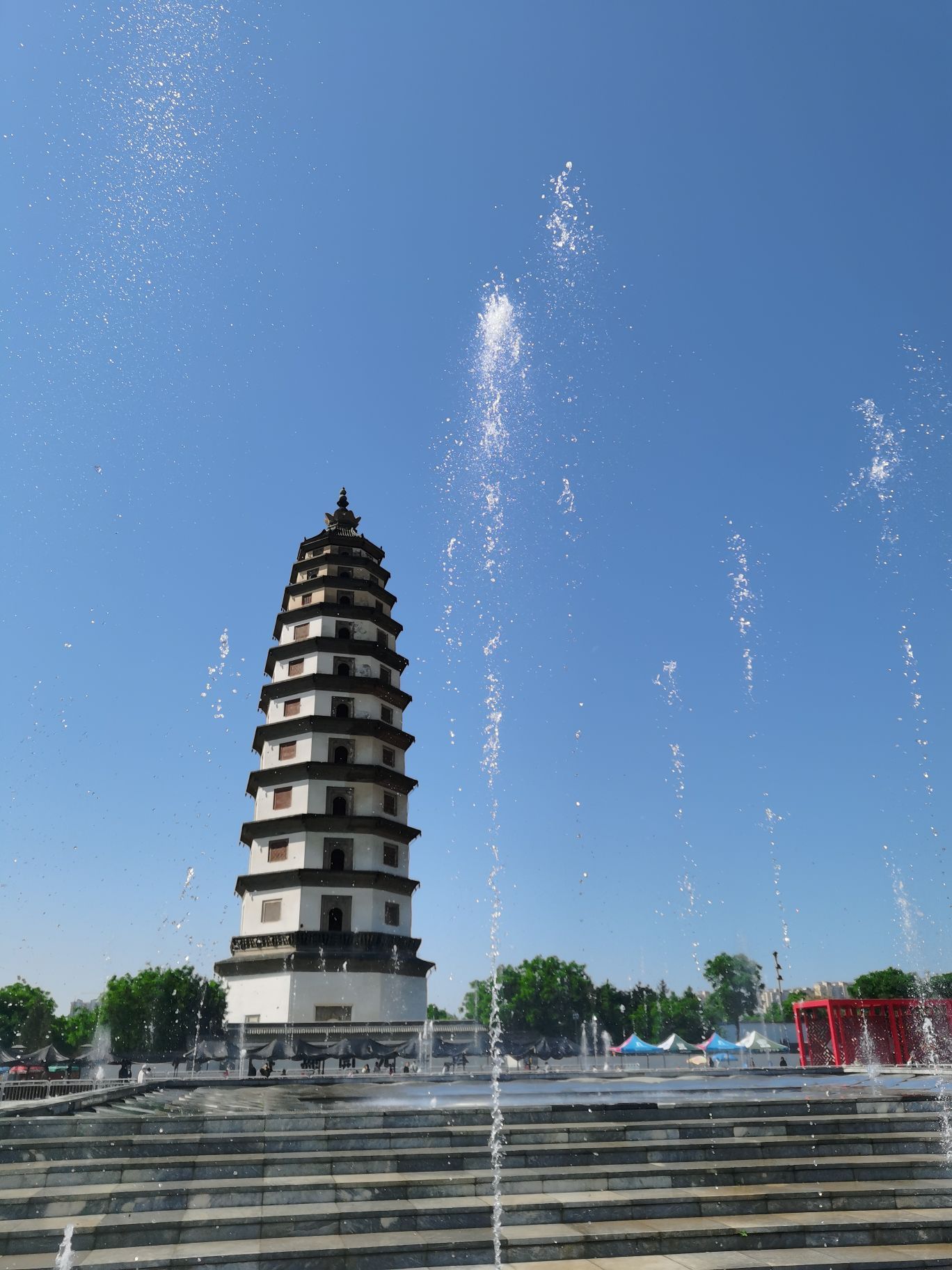
Kaiyuan Temple Pagoda Dingzhou.
Nearby Attractions
While in Quanzhou, consider visiting other historical sites to round out your cultural experience:
- Luoyang Bridge: An ancient bridge renowned for its architectural beauty.
- Confucius Temple: A serene spot reflecting Confucian philosophy and teachings.
- Quanzhou Maritime Museum: Offers further insights into the maritime history of the region.
Conclusion
Visiting Kaiyuan Temple Pagoda Dingzhou is more than just a sightseeing trip; it is a journey through time that reveals the profound history and spirituality of Chinese Buddhism. With its captivating architecture, serene atmosphere, and rich cultural context, this temple is a treasure waiting to be explored by travelers from around the globe.
Tickets: Prices, Booking, and Tips
Discovering Kaiyuan Temple: Admission Details and Visitor Tips
Visiting the historic Kaiyuan Temple in Quanzhou is an enriching experience, steeped in over 1,300 years of Buddhist tradition and architectural splendor. Here’s everything you need to know about ticketing, booking, and tips for making the most of your visit.
Admission Fees
- Entry Cost: Free
One of the delightful aspects of Kaiyuan Temple is that admission is completely free of charge. This allows travelers to explore this significant cultural landmark without any financial barrier.
Opening Hours
- Daily Hours: 8:00 AM – 6:00 PM
The temple welcomes visitors throughout the week during these hours. Arriving early can provide a more tranquil experience, particularly if you’re interested in photography or quiet contemplation.
Recommended Visit Duration
- Suggested Time: 2 to 3 hours
While you can certainly see the main highlights in a shorter time, allocating a few hours will allow you to appreciate the intricate details of the architecture, the serene atmosphere, and the historical context of the site.
Tips for Your Visit
-
Research Ahead:
Familiarize yourself with the temple’s rich history and architectural significance before your visit. This knowledge will enhance your appreciation as you walk through the grounds. -
Consider a Guide:
Engaging a local guide can provide invaluable insights into the temple’s hidden stories and cultural relevance, especially regarding its connection to Quanzhou’s maritime history. -
Plan for Crowds:
During peak tourist seasons, the temple can become quite crowded. If possible, visit during weekdays or off-peak hours to enjoy a more peaceful experience. -
Respect the Rules:
Photography is prohibited in the Buddha hall, so be sure to follow the guidelines to maintain the sanctity of the site. -
Explore the Surroundings:
After visiting the temple, take time to explore the vibrant food streets nearby, where you can sample local delicacies. Be mindful that vegetarian options may be limited. -
Comfortable Attire:
Dress comfortably and wear appropriate footwear, as you will be walking through a large area and may want to spend time exploring. -
Stay Hydrated:
Especially during warmer months, carry water with you to stay refreshed as you explore.
By following these guidelines, you can ensure a rewarding visit to Kaiyuan Temple, immersing yourself in the cultural and historical tapestry that defines this remarkable site.
How to Get There: A Complete Transportation Guide
Getting to Kaiyuan Temple Pagoda Dingzhou: Your Comprehensive Transportation Guide
Visiting the Kaiyuan Temple Pagoda in Dingzhou (定州开元寺塔) is a remarkable journey into China’s rich cultural and historical tapestry. Nestled within the ancient city of Dingzhou, this iconic site is accessible through various modes of transportation that cater to international travelers. Below, we outline the best ways to reach this significant landmark.
By Air
Nearest Airport: Shijiazhuang Zhengding International Airport (SJW)
– Distance to Dingzhou: Approximately 60 kilometers (37 miles)
– Transportation Options from the Airport:
– Taxi: The most convenient option. Expect a fare of around ¥150-¥200 (approximately $22-$30) and a travel time of about 1 hour.
– Airport Shuttle: Look for shuttles heading to Shijiazhuang city, then transfer to a local bus or taxi to Dingzhou.
By Train
Dingzhou Railway Station
– Train Options: Dingzhou is well-connected by high-speed trains from major cities.
– From Beijing: High-speed trains run frequently, taking about 1.5 to 2 hours. Tickets range from ¥70 to ¥150 ($10-$22).
– From Shijiazhuang: A short ride of about 30-40 minutes. Tickets cost around ¥40 ($6).
– Getting to the Temple: Once you arrive at Dingzhou Railway Station, you can take a taxi (approximately ¥20, $3) or a local bus to the Kaiyuan Temple Pagoda.
By Bus
Long-Distance Bus Stations
– From Beijing: Take a bus from the Beijing Zhaogongkou Bus Station. The journey takes approximately 3-4 hours, with fares ranging from ¥80 to ¥120 ($12-$18).
– From Shijiazhuang: Buses from Shijiazhuang Central Bus Station to Dingzhou take about 1.5 hours, costing around ¥30 ($5).
– Local Transport: Once in Dingzhou, local buses or taxis are available to reach the temple. A taxi ride will cost around ¥10-¥15 ($1.50-$2.20).
By Car
Driving Directions
– If you prefer to drive, the route from Beijing to Dingzhou is straightforward via the G4 Beijing-Hong Kong-Macau Expressway. The trip takes about 1.5 to 2 hours, depending on traffic.
– Parking: There are parking facilities available near the temple complex, making it convenient for self-drive visitors.
Local Transportation
- Taxis: Widely available and a reliable way to get around Dingzhou. Ensure to have your destination written in Chinese for the driver.
- Bicycles and E-scooters: Renting a bicycle or an e-scooter can be a fun and eco-friendly way to explore the area surrounding the Kaiyuan Temple.
Tips for a Smooth Journey
- Language: While some taxi drivers may speak basic English, having the destination written in Chinese can be very helpful.
- Cash: Although digital payments are prevalent, carrying some cash (Chinese Yuan) can be beneficial, especially in rural areas.
- Timing: Consider visiting on weekdays to avoid crowds, especially during peak tourist seasons.
With this transportation guide, navigating your way to the Kaiyuan Temple Pagoda Dingzhou will be a breeze, allowing you to fully immerse yourself in the historical wonders that await. Happy travels!
Local Cuisine and Accommodation Nearby
As you explore the rich history and breathtaking architecture of Kaiyuan Temple Pagoda in Dingzhou, immerse yourself in the local flavors and comfortable accommodations that Quanzhou has to offer. This vibrant city, steeped in maritime heritage, presents a culinary landscape that reflects its diverse cultural influences, alongside a range of lodging options to suit every traveler’s needs.
Local Cuisine
Quanzhou is renowned for its unique culinary offerings, where the fusion of flavors tells the stories of its past. Here are some must-try dishes and dining spots near Kaiyuan Temple:
-
Bawan (肉圓): A traditional dish made from glutinous rice flour, filled with pork and vegetables, and often served with a sweet and spicy sauce. Look for local vendors around the temple for an authentic experience.
-
Seafood Delicacies: Given its coastal location, Quanzhou boasts a plentiful supply of fresh seafood. Don’t miss out on trying Grilled Oysters and Stir-fried Clams, available at various food stalls and small restaurants nearby.
-
Duck Dishes: Quanzhou is famous for its roasted duck, particularly Soya Sauce Duck (卤鸭), which is marinated in a rich blend of spices, giving it a mouthwatering flavor. Head to Zhengdong Roast Duck Restaurant for a well-regarded version.
-
Teochew Porridge (潮州粥): A comforting rice porridge served with a variety of side dishes, including pickled vegetables and fried fish. It’s a popular breakfast choice among locals and is available at many eateries throughout the area.
-
Sweet Treats: Don’t forget to try Peanut Soup (花生汤), a sweet dessert made from ground peanuts and served warm. It’s often sold at street stalls near the temple.
Cafés for Relaxation
After indulging in the local cuisine, take a break in one of Quanzhou’s charming cafés. Many offer a cozy ambiance and a selection of beverages perfect for relaxing after your temple visit:
-
Café Lattice: Known for its artisan coffee and homemade pastries, this café is a great spot to unwind and enjoy a moment of tranquility.
-
Tea House of the South: Experience traditional Chinese tea culture in this serene setting, where you can sample various teas and learn about their significance.
Accommodation Options
Finding a comfortable place to stay in Quanzhou enhances your travel experience. There’s a range of accommodations near the Kaiyuan Temple to fit different budgets and preferences:
-
Quanzhou Hotel: A well-established hotel offering modern amenities and a convenient location near the temple. Ideal for travelers looking for comfort and accessibility.
-
Hanting Express Quanzhou: A budget-friendly option with clean, simple rooms. It provides easy access to local attractions and dining options.
-
Wanda Vista Quanzhou: For those seeking luxury, this five-star hotel features elegant rooms, exquisite dining, and a spa, all within a short distance from the temple.
-
Hostel Options: If you’re a solo traveler or backpacker, consider staying at a local hostel like Dreaming of Quanzhou Hostel. This option not only offers affordable rates but also a chance to meet fellow travelers.
Conclusion
Quanzhou’s rich tapestry of flavors and comfortable accommodations provides an ideal backdrop for your visit to the historic Kaiyuan Temple Pagoda. From indulging in local delicacies to finding a welcoming place to rest, your experience in this culturally vibrant city is sure to be memorable. Be sure to take the time to savor both the history and the tastes of Quanzhou as you embark on your journey.
Frequently Asked Questions
Frequently Asked Questions
1. What is the historical significance of Kaiyuan Temple?
Kaiyuan Temple, built in 685 AD during the Tang Dynasty, is one of the oldest and largest Buddhist temples in Fujian Province. It serves as a vital symbol of Quanzhou’s maritime culture and trade, reflecting the city’s rich historical tapestry. The temple features impressive architecture, including stone pagodas adorned with intricate carvings.
2. Is there an admission fee to visit Kaiyuan Temple?
No, admission to Kaiyuan Temple is free. Visitors can explore the temple grounds and its significant features without any entry charges. However, it’s advisable to respect the rules, especially in areas where photography is prohibited.
3. How long should I plan to spend at Kaiyuan Temple?
Visitors typically recommend allowing 2 to 3 hours to fully appreciate the beauty and historical significance of the temple. This time frame will allow you to explore the various halls, admire the architecture, and soak in the serene atmosphere.
4. What are the opening hours of the temple?
Kaiyuan Temple is open daily from 8:00 AM to 6:00 PM. It’s best to arrive early in the day to avoid crowds and make the most of your visit.
5. Are there any guided tours available?
Yes, hiring a local tour guide is highly recommended for a more enriching experience. A guide can provide insights into the temple’s history, architecture, and cultural significance, revealing stories that you might miss on your own.
6. What should I know about photography at the temple?
While photography is allowed in most areas of Kaiyuan Temple, it is not permitted inside the Buddha hall. Visitors are kindly requested to adhere to this rule out of respect for the sacred space.
7. What amenities are available around Kaiyuan Temple?
The area surrounding Kaiyuan Temple features unique food streets offering local delicacies, including seafood and roasted duck. There are also charming coffee shops nearby for a refreshing break. However, vegetarian options may be limited, so plan accordingly.
8. When is the best time to visit Kaiyuan Temple?
You can visit Kaiyuan Temple at any time of the year. However, it’s wise to avoid peak tourist seasons if you prefer a quieter experience. Visiting during weekdays or early mornings may help you navigate the crowds more easily.
Final Thoughts on Your Trip
As your journey through the enchanting Kaiyuan Temple comes to a close, take a moment to reflect on the unique tapestry of history and culture woven within its ancient walls. With its origins tracing back to the Tang Dynasty, this temple not only stands as a testament to the architectural prowess of its time but also embodies the spirit of Quanzhou—a city that has long been a crossroads of cultures.
A Journey Worth Remembering
Why Visit?
– Rich History: From the moment you step inside, you are enveloped in a sense of tranquility and reverence, surrounded by centuries of devotion and artistry.
– Architectural Marvel: The twin stone pagodas, intricately carved pillars, and the solemn Buddha hall provide a visual feast that captivates the imagination.
– Cultural Significance: As one of the largest and most well-preserved Buddhist complexes in Fujian, the temple serves as a living museum of maritime trade and spiritual exchange.
Practical Tips for Your Visit:
– Allow Time to Explore: Plan to spend at least three hours to fully appreciate the temple and its surroundings. Don’t rush; let the ambiance seep in.
– Engage a Local Guide: To unlock the deeper stories behind the temple’s architecture and history, consider hiring a knowledgeable guide. Their insights can enhance your experience immensely.
– Enjoy Local Delicacies: After your exploration, treat yourself to the vibrant food stalls nearby where you can taste the local flavors, but be mindful of the vegetarian options.
Your Next Steps
As you leave the Kaiyuan Temple, carry with you the memories of this sacred space—where spirituality meets history, and where the past continues to inspire the present. Whether you’re a history buff, a cultural enthusiast, or simply a curious traveler, the stories of Kaiyuan will linger in your heart long after your visit. Quanzhou, and the Kaiyuan Temple in particular, invites you to uncover the layers of its rich heritage, making it a must-visit destination on your journey through China.
Safe travels!